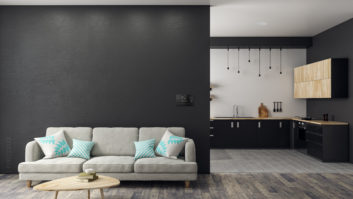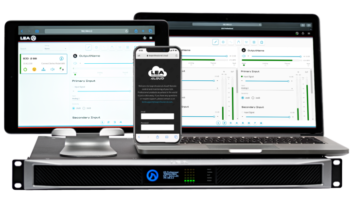 While nearly every home of every size has networking in the form of a Wi-Fi system for accessing the internet, a smaller but rapidly growing number incorporate structured cabling (CAT5E or CAT6) for more robust network use. Higher-end homes are more likely to include this as a default, but it is becoming more common in mid-priced homes as well. In addition to the AV uses described in this article, a wired network provides a more consistent and fast connection for internet usage, a key value for gamers and tech workers working remotely.
While nearly every home of every size has networking in the form of a Wi-Fi system for accessing the internet, a smaller but rapidly growing number incorporate structured cabling (CAT5E or CAT6) for more robust network use. Higher-end homes are more likely to include this as a default, but it is becoming more common in mid-priced homes as well. In addition to the AV uses described in this article, a wired network provides a more consistent and fast connection for internet usage, a key value for gamers and tech workers working remotely.
As more homes sport wired network infrastructure, AV applications that were commonly considered as ‘pro AV’ are now growing in usage in the residential world. AV-over-IP is a rapidly expanding trend in the AV industry, migrating systems away from legacy point-to-point connection strategies to universally connected network devices capable of sending signals to one another regardless of location or distance in the installation. Networked AV is a natural fit for larger homes where devices may be spread among different rooms and areas, even outdoors. Handling large numbers of connected devices with large channel counts is something that networked AV does extremely well, and is a large part of why it now dominates many areas of professional AV.
Social change
The past year and a half have brought many changes to the ways we work, and the ways we socialise. Out of necessity, many activities we used to do at offices and studios have moved to our homes. The now ubiquitous video conference calls drove many to purchase new computers, headphones, and microphones. For professionals in entertainment and broadcast, it meant something more.
Home recording studios have often been personal creative spaces, but with social distancing rules in place they evolved into something new. Using the networked AV already popular in the space, studio owners were able to create ways to keep musicians safe while getting great work done. The Farm Studios in British Columbia, Canada was able to link separate rooms and even buildings to performers, allowing a single Ethernet cable to handle all signal and control. Some performers even take the show outdoors, easily rolling out CAT5E into the surrounding woods. Home studios have enabled music-making to stay vibrant during an otherwise difficult time.
Talking tech
The hosts of late-night talk shows made no effort to hide the fact that for several weeks or months in 2020 they were doing their programs from their homes, with an oft-times charming effect. The challenge of capturing, combining, and distributing all the audio in their programs from attics and bedrooms was aided by AV networking, allowing one slender cable to carry all the information needed back to an OB truck. If the house was already wired with structured cabling, this job was made easier, and any port in the home could be used to connect microphones and recording devices.
Sports commentators were at home more often than at games, and AV networking was there to ensure they could safely deliver commentary in real-time from the safety of their kitchens, home offices, garages, or elsewhere, with audio delivered via OB truck or low-latency internet connections.
Shutdown benefits
Not surprisingly, one of the biggest beneficiaries of the shutdown was the makers of entertainment systems. People couldn’t go out, and so they spent their money on improvements to televisions, loudspeakers, AV receivers, and media. This growth extended across a wide range of buyers and homes, from people getting their first HDTV to massive home theatre installations. At the higher end, the use of AV networking grew as more users and manufacturers discovered how easy it is to use and how well it can cover large, complex living spaces.
While some things are bound to return to what we once called ‘normal’, some things are real improvements that will stay. It increasingly appears that working from home will be considered very much a normal mode for many people, along with part-time use of office space. Home AV is likely to continue to be of great importance with more time at home and high-quality audio for remote meetings being a ‘must-have’ for many.
While high-end home audio has always had some overlap with professional audio, that is likely to increase in one particular area: networking. Audio networking first found its home among live sound professionals who like how easy it is to set up, and how well it handles large-scale systems with many endpoints and many channels. Many of the elements that drove live sound to networking are present in residential systems: many devices each with many channels, substantial distances to cover, and a need for pristine, high-quality signals. Since audio networking is a completely lossless digital medium, it is very well suited to high-end installations for discriminating listeners.
Unique demands
Unlike professional audio, residential systems are meant to be operated by non-technical people. Complex terminology and fussy configurations are not acceptable, and so the systems that are installed must provide intuitive controls that present users with understandable choices and reliable results. Control panels that can speak to many endpoints at once to perform these tasks – choose media, choose locations, adjust volume, etc – are essential to avoid confusion and provide useful metaphors to customers.
The most universally useful thing to have in a residential design is a backbone of structured Ethernet cabling that is well documented. The reasons are simple; wired gigabit networking is incredibly robust and can be used for countless purposes in a home, ranging from entertainment to home offices to security systems. It allows more advanced computer-based products of all kinds to be used to maximum effect, such as home-based media servers and home-based businesses. It is very cost-effective, easy to install, and in no way precludes the use of WiFi for phones, tablets, and other wireless devices.







